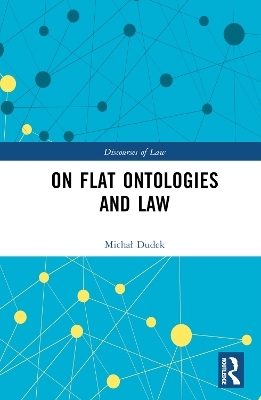
On Flat Ontologies and Law
Routledge (Verlag)
978-1-032-57779-1 (ISBN)
This book will appeal mainly to scholars and students in legal theory and sociolegal studies; as well as others with interests in the posthumanist turn in philosophy and social theory.
Michał Dudek is Assistant Professor in the Department of Sociology of Law at the Faculty of Law and Administration, Jagiellonian University in Kraków, Poland.
List of figures
Acknowledgements
1 Introduction: Law, its Ontologies and the Mere Idea of Flat Ontology; or, How Flat Ontologies Differ from Ontologies of Law and Why Should We Care?
1.1 Adequacy Question and Value Question
1.2 What is Meant by “Law”?
1.2.1 LAW, Law or law?
1.2.2 Text and Meaning and Media for Them
1.2.3 Top-Down and Bottom-Up Geneses of Law
1.2.4 Social Communication About Law
1.2.5 Law’s Materiality
1.3 Preliminaries on Flat Ontology
1.3.1 Basics of Genealogy
1.3.2 Problem of Too Narrow Conceptualisations
1.3.3 The Mere Idea of Flat Ontology – A Proposal and General Characteristics
1.3.4 Addressing Incorrect Impressions
1.3.5 Illustration and Test of Removal
1.4 On Ontologies of Law (in Relation to Flat Ontology)
1.4.1 Need for Review and Its Guiding Assumptions
1.4.2 Materiality Ignorance
1.4.3 Materiality Belittling
1.4.4 Intermezzo on Contemporary Analytical Social Ontology
1.4.5 Modest Materiality Equalisation
1.4.6 Some Self-Criticism
1.4.7 Early Reflections on Flat Ontology and Ontologies of Law
1.4.8 Flat Ontology-Inspired Ontologies of Law (and Other Legal Studies)
1.5 Reasons for the Investigations and Their General Course
1.5.1 Situating the Book
1.5.2 Representative Sample of Flat Ontologies
1.5.3 Adopted Approach
2 Gabriel Tarde’s Monadology (of Law); or, Will Law Still Exist If Some Parts of It Are Removed?
2.1 Not … an Easily Classifiable Thinker
2.1.1 Also a Science-Fiction Author
2.1.2 Forgotten but Rediscovered
2.1.3 One Great Work or Many Great Works?
2.2 Stepping Into … Tardean Monadology
2.2.1 Scepticism
2.2.2 Anti-holism
2.2.3 The Big, the Small and Relational Character of Properties
2.2.4 Having Instead of Being
2.2.5 Avidity
2.2.6 Posthumanism
2.2.7 Monadological Understanding of Society
2.2.8 Tardean Monadology as Flat Ontology
2.3 Focusing on … Monads
2.3.1 Formal, Relative, Compositional and Linked
2.3.2 On Possession(s), Being Avid, Dominant and Leading Monad
2.3.3 The Big’s Simplicity and Fragility and the Small’s Complexity and Independence
2.4 Law and … Tarde’s Monads
2.4.1 Law as Not an Emergent Entity
2.4.2 Law’s Utter Fragility
2.4.3 Independence of Law’s Small
2.4.4 Heterogeneity of Law’s Composition
2.4.5 Law’s Avidity
3 Bruno Latour’s Actor-Network Theory (of Law); or, What About Law’s Outside (Plasma)?
3.1 Not … a Winemaker
3.1.1 After Tarde
3.1.2 A Bird’s-Eye View at Latour’s Oeuvre
3.1.3 “Latour and Law? Just Not That Again!”
3.1.4 Actor-Network Theory or Theories?
3.1.5 On an Inquiry into Modes of Existence Project
3.2 Stepping into … Latourian Actor-Network Theory
3.2.1 To Exist by Actions, to Act and Become Stronger (and Weaker) Thanks to Allies
3.2.2 Against Domains, Hierarchies and Critique, For Descriptivism
3.2.3 Nonhumans as Actors, Delegates, Mediators and Intermediaries
3.2.4 Scattering of Action
3.2.5 Significance of Nonhumans for Humans
3.2.6 Issue of (Anti)Essentialism, Translation and the Irreduction Principle
3.2.7 What About (Anti)Emergentism?
3.2.8 (Claim to) Universality
3.2.9 Latourian Actor-Network Theory as Flat Ontology
3.3 Focusing on … Actor-Networks
3.3.1 Not Only Synonyms
3.3.2 Broad Sense of Action
3.3.3 Against Potentiality
3.3.4 (Scattering of Action and) Basic Features of Interactions
3.3.5 Reasons for the Inevitability of Translations
3.3.6 Basic Ways of Becoming Stronger
3.3.7 Mediators and Intermediaries
3.3.8 Delegates
3.3.9 Plasma
3.4 Law and … Latour’s Actor-Networks
3.4.1 Is There Anything Beyond Law?
3.4.2 Is There Anything Beyond Law that Law Can Act Upon?
3.4.3 Law’s Functioning (But Not by Itself)
3.4.4 Sources of Law’s Strength (and Weakness)
3.4.5 Law as a Chain of Mediations and Delegations
4 Manuel DeLanda’s Assemblage Theory (of Law); or, Can Law’s Components Exist Outside Law?
4.1 Not … a Filmmaker (Anymore)
4.1.1 Snapshot of DeLanda’s Work
4.1.2 Drawing from Many Sources (Not without Controversy)
4.1.3 Some Deviations from DeLanda (In What is to Follow)
4.1.4 Reservation Concerning Virtuality and the Diagram
4.2 Stepping into … DeLandaean Assemblage Theory
4.2.1 One Plane, Many Scales, No Essences and No Transcendence
4.2.2 Realism
4.2.3 Immanence, Historicity and Contingency
4.2.4 Emergence, Properties, Tendencies and Capacities
4.2.5 Against Micro- and Macroreductionism
4.3 Focusing on … Assemblages
4.3.1 Emergent Whole
4.3.2 Bottom-Up, Top-Down and Exteriority Relations
4.3.3 Materiality and Expressivity of Components
4.3.4 (De)Territorialisation and (De)Coding
4.3.5 DeLandaean Assemblage Theory as Flat Ontology
4.4 Law and … DeLanda’s Assemblages
4.4.1 Law as an Emergent Whole
4.4.2 Material and Expressive Components of Law
4.4.3 Law’s Components in Relations of Exteriority
5 Karen Barad’s Agential Realism (of Law); or, Does Law Fit the Binary or Non-binary Model of Intra-Action?
5.1 Not … an “Ordinary” Physicist (Anymore)
5.1.1 Note on New Materialism(s)
5.1.2 Why Barad?
5.1.3 From Lattice Gauge Theory to …
5.1.4 Baggage of Physics, Ethico-Onto-Epistemology and Addressing the Unaddressed Issue (Just Another One)
5.2 Stepping Into … Baradian Agential Realism
5.2.1 Anti-individualism and Priority of Relations
5.2.2 Dynamism, Anti-essentialism and Against (Presupposed) Domains
5.2.3 Post-anthropocentrism (and a Short Remark on Baradian Agential Realism as Flat Ontology)
5.2.4 Anti-representationalism and Moving Past the Divide of Realism and Social Constructivism
5.2.5 Interpreting Bohr Extendingly
5.3 Focusing on … Intra-Actions
5.3.1 Neither Kantian Noumenon nor Phenomenon, but Close to Bohrian Phenomenon
5.3.2 Bohrian Model (In Baradian Interpretation)
5.3.3 Baradian Model
5.3.4 Problems with Binarism
5.3.5 Beyond the Binary Model
5.4 Law and … Barad’s Intra-Actions
5.4.1 Law from Intra-Action with Something, Something from Intra-Action with Law
5.4.2 Dual Responsibility of Law and Transgressing the Input and Output of Law Distinction
5.4.3 Law Regulating Only That What is Already Legal
5.4.4 Rejecting the Classical Distinctions
5.4.5 Adequacy for Law Between the Binary and Non-Binary Intra-Action
6 Graham Harman’s Object-Oriented Ontology (of Law); or, Is Law Exhausted by Under- and Overmining?
6.1 Not … a Sports Reporter (Anymore)
6.1.1 To Be in Constant Development (and the Downsides of That)
6.1.2 Classifying the Works of Harman
6.1.3 Second Wave of Object-Oriented Ontologies and Speculative Realism
6.2 Stepping Into … Harmanian Object-Oriented Ontology
6.2.1 Against Onto-Taxonomy, For Objectifying Everything (Humans Included)
6.2.2 Against (Overestimating) Changes, for (Appreciating) Stability
6.2.3 Essentialism
6.2.4 The Real and the Sensual
6.2.5 Pan(?)experientialism
6.2.6 Withdrawal
6.2.7 Unknowability of the Real
6.3 Focusing on … Objects
6.3.1 Towards the Current Model
6.3.2 Between Undermining and Overmining, and Complete, Exclusively Sensual and Exclusively Real Object
6.3.3 Harmanian Object-Oriented Ontology as Flat Ontology
6.3.4 Not Only Real and Sensual, and Objects, but Also … Qualities
6.3.5 Object-Object Relations and Emergence
6.4 Law and … Harman’s Objects
6.4.1 Some Law’s Components Are Real Objects, Some Are Not
6.4.2 Law, Real-Sensual, Object-Qualities Distinctions and Harmanian Emergence
6.4.3 Around Law and Domestic and Foreign Relations
6.4.4 A Few Final Thoughts
7 Conclusion: Flat Ontologies – With Some Adequacy Problems, Yet Valuable to Law; or, What Comes of It All?
7.1 The Adequacy Question
7.2 The Value Question
7.3 Doing Justice
7.4. What to Do Next?
Index
| Erscheinungsdatum | 21.04.2024 |
|---|---|
| Reihe/Serie | Discourses of Law |
| Zusatzinfo | 10 Line drawings, black and white; 10 Illustrations, black and white |
| Verlagsort | London |
| Sprache | englisch |
| Maße | 156 x 234 mm |
| Gewicht | 620 g |
| Themenwelt | Geisteswissenschaften ► Philosophie |
| Recht / Steuern ► Allgemeines / Lexika | |
| Recht / Steuern ► Arbeits- / Sozialrecht ► Sozialrecht | |
| Recht / Steuern ► EU / Internationales Recht | |
| Sozialwissenschaften | |
| ISBN-10 | 1-032-57779-7 / 1032577797 |
| ISBN-13 | 978-1-032-57779-1 / 9781032577791 |
| Zustand | Neuware |
| Haben Sie eine Frage zum Produkt? |
aus dem Bereich


